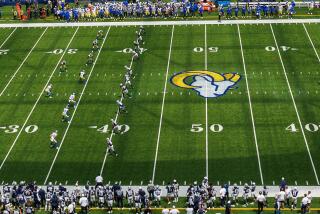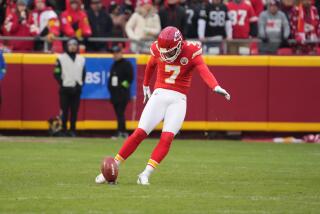Rules of the Game
- Share via
OFFSIDE
1) An attacking player is in an offside position when he is in the opposing team’s side of the field and is closer to the goal line than all defenders other than the goalie.
2) An attacking player can be in an offside position as long as the referee rules that he is not receiving a pass, seeking to gain an advantage or interfering with play.
3) In the majority of cases, a judgment on whether a player is violating the rule is made at the moment the ball is passed to him by a teammate.
4) After the ball is played to him, a player is allowed to receive a pass in an offside position.
5) The penalty for offside is an indirect free kick.
THEATRICS
One of the most difficult calls for a referee occurs on tackles. Players will often feign being tripped and take acrobatic dives when the ball is legally taken from them. This is especially true in the penalty area, where attackers try to win a penalty kick call. Such theatrics are considered ungentlemanly conduct, but are rarely penalized by a yellow card.
THE OFFSIDE TRAP
Defending teams will often employ an offside trap in which they move up the field in unison (A) to leave the attackers in an offside position (B). However, if the attack fails, an attacker will often have a breakaway.
RULE CHANGES
1) Defending teams will no longer be allowed to pass the ball back to the goalie so he can play the ball with his hands. A goalie receiving a back pass will have to play the ball with his feet or the opposing team receives an indirect free kick.
2) In an attempt to speed up the game, players who feign injury in the 1994 World Cup will receive a yellow card. Injured players will be immediately stretchered off the field to the sideline.
DIRECT AND INDIRECT FREE KICK
Direct free kick: A free kick from which a goal may be scored. It is awarded for a serious rule violation.
Indirect free kick: A free kick from which a goal may not be directly scored.
PENALTY KICK
A penalty kick is awarded for all direct-kick infractions that occur within the penalty area. The penalty kick is taken from the penalty mark, 12 yards from the goal line. All players other than the shooter and the goalie must be out of the area, 10 yards from the penalty mark at the time of the kick. The shooter cannot play the ball a second time until it is touched by another player. Goalie must stand on his goal line until the ball is kicked.
GLOSSARY
* Advantage--A discretionary decision by the referee in which he decides not to stop play after a foul because the team whose player was fouled is mounting an attack and would be hurt by a stoppage.
* Cards--A referee’s official warning to a player who has committed a serious offense results in a yellow card. A subsequent similar infraction results in a red card and immediate ejection. The player may not be replaced.
* Injury time--Time allowed at the end of a half to compensate for time lost because of an injury or other stoppages.
* Obstruction--A violation in which a player intentionally places his body between an opponent and the ball to gain an advantage. It results in an indirect free kick.
* Send-off--The ejection of a player with a red card.
* Substitution--Only two substitutions of field players allowed by each team per game. The goalkeeper can also be replaced by another goalkeeper.
PLAYING THE BALL
Soccer’s most basic rule is that only the two goalies are allowed to intentionally play the ball with their hands on the field of play. A referee may rule that although a ball hit a player’s hand or arm, the contact was accidental and his team did not gain an advantage as a result. Also, playing the ball intentionally with the hands, to prevent a goal for instance, will receive a yellow card for ungentlemanly conduct. Players are allowed to use any other part of their bodies to play the ball, resulting in chest traps, headers etc. The penalty for a hands ball is a direct free kick.
Sources: The Encyclopedia of Soccer; The Simplest Game: The Intelligent Fan’s Guide to the World of Soccer
More to Read
Go beyond the scoreboard
Get the latest on L.A.'s teams in the daily Sports Report newsletter.
You may occasionally receive promotional content from the Los Angeles Times.









